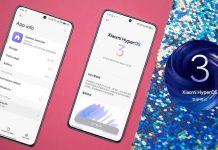Xiaomi’s innovative HyperOS, the company’s next-generation Android-based operating system, is experiencing a significant rollout acceleration. Following its initial launch in the Indian market at the end of February 2024, Xiaomi has unveiled a comprehensive update schedule for Q2 2024. This expansion promises to deliver a superior user experience across a vast array of Xiaomi and Redmi devices.
A Diverse Device List for Widespread HyperOS Adoption
The upcoming Q2 2024 rollout encompasses a comprehensive selection of smartphones and tablets, ensuring a broader user base can leverage the numerous benefits of HyperOS. The extensive list includes popular models like:

- Xiaomi Series: Xiaomi 11 series (Lite, 11i, 11i HyperCharge, 11T Pro, Mi 11 Ultra, Mi 10)
- Redmi Series: Redmi K50i, Redmi 12 series, Redmi 11 Prime, entire Redmi Note 11 series, Redmi 13C series
Even the Xiaomi Pad 5 tablet is slated to receive the HyperOS update, solidifying Xiaomi’s commitment to providing a unified user experience across its entire device portfolio.
HyperOS: Unlocking Enhanced Performance and User Experience
HyperOS prioritizes optimizing core functionalities to deliver a smoother and more efficient user experience. Here’s a breakdown of the key improvements:
Smoother System Performance: HyperOS boasts a streamlined architecture designed to enhance overall system performance. Users can expect faster app loading times, improved multitasking capabilities, and a noticeably smoother user interface.
Faster Task Switching: HyperOS optimizes memory management, allowing users to seamlessly switch between applications without experiencing lag or performance drops.
Enhanced Message Delivery Reliability: HyperOS ensures messages are delivered more reliably, minimizing communication disruptions.
Reduced System Storage Footprint: HyperOS is designed to occupy less storage space compared to its predecessor, MIUI 14. This translates to smaller and quicker over-the-air (OTA) updates, minimizing wait times and data consumption.
Beyond Performance: Aesthetic and Functional Upgrades in HyperOS
Apart from performance enhancements, HyperOS introduces a wave of aesthetic and functional upgrades to elevate the user experience:
Lock Screen Customization: HyperOS empowers users to personalize their lock screens with a wider range of themes, wallpapers, and widgets.
Redesigned Control Center: The control center in HyperOS receives a facelift, offering a more intuitive and streamlined layout for managing frequently used functionalities.
Workstation Mode for Tablets: Specifically designed for tablets, Workstation Mode in HyperOS provides a desktop-like experience, facilitating multitasking and productivity workflows.
Interconnectivity and Future Roadmap for HyperOS
One of the core philosophies behind HyperOS is fostering seamless device connectivity. Here’s a glimpse into the future possibilities:
Phone Screen Mirroring: With HyperOS, users might be able to mirror their phone screen to a tablet, ideal for presentations or entertainment on a larger display.
Smart Home Integration: HyperOS could potentially allow users to control their smart home devices seamlessly through the Xiaomi Smart Hub, creating a more integrated and convenient smart living experience.
Xiaomi has already deployed HyperOS on select flagship devices like the Xiaomi 13 and 12 Pro series, Redmi Note 12 and 13 series, Xiaomi Pad 6, and Redmi Pad. This initial rollout demonstrates Xiaomi’s commitment to delivering the latest software experiences to its users.
Looking ahead, Xiaomi plans to integrate HyperOS into upcoming devices, encompassing new smartphones, smart home gadgets, and potentially even electric vehicles like the Xiaomi SU7. This comprehensive integration signifies Xiaomi’s vision for a future where HyperOS serves as the unifying platform for a streamlined, customizable, and interconnected ecosystem of Xiaomi devices.
FAQs
1. What is HyperOS?
HyperOS is Xiaomi’s new Android-based operating system aimed at enhancing performance, user experience, and device connectivity across its range of smartphones and tablets.
2. Which Xiaomi devices will receive the HyperOS update in Q2 2024?
Several Xiaomi and Redmi devices, including the Xiaomi 11 series, Redmi K50i, Redmi 12 series, Redmi 11 Prime, various models from the Redmi Note 11 series, and the Xiaomi Pad 5 tablet, are scheduled to receive the HyperOS update in Q2 2024.
3. What improvements can users expect from HyperOS?
HyperOS promises smoother system performance, faster task switching, more reliable message delivery, reduced system storage footprint, aesthetic enhancements like customizable lock screens and a revamped control center, and new productivity tools such as Workstation Mode for tablets.
4. How does HyperOS prioritize device connectivity?
HyperOS emphasizes device connectivity by enabling users to mirror their phone screen to a tablet and control smart home devices through the Xiaomi Smart Hub.
5. Are there plans to integrate HyperOS into other Xiaomi products?
Yes, Xiaomi plans to integrate HyperOS into upcoming devices, including smartphones, smart home gadgets, and potentially even electric vehicles like the Xiaomi SU7.




